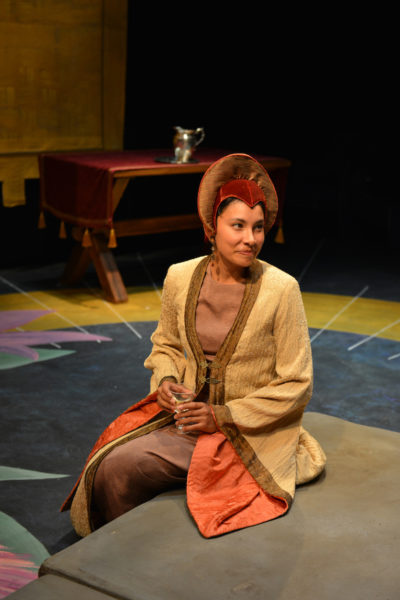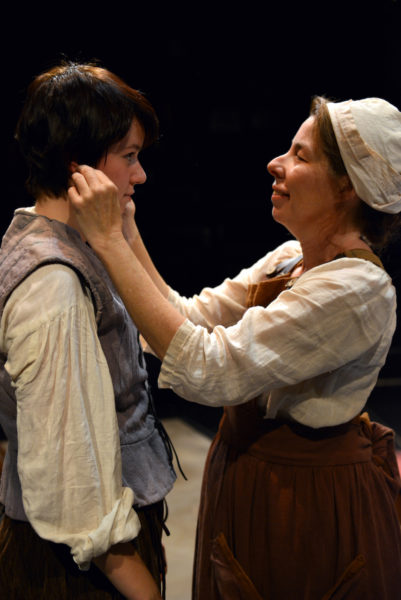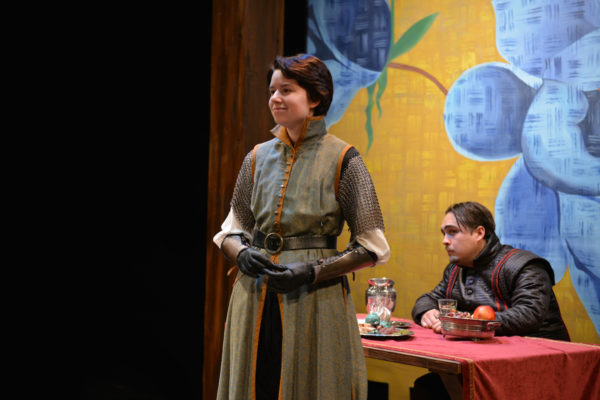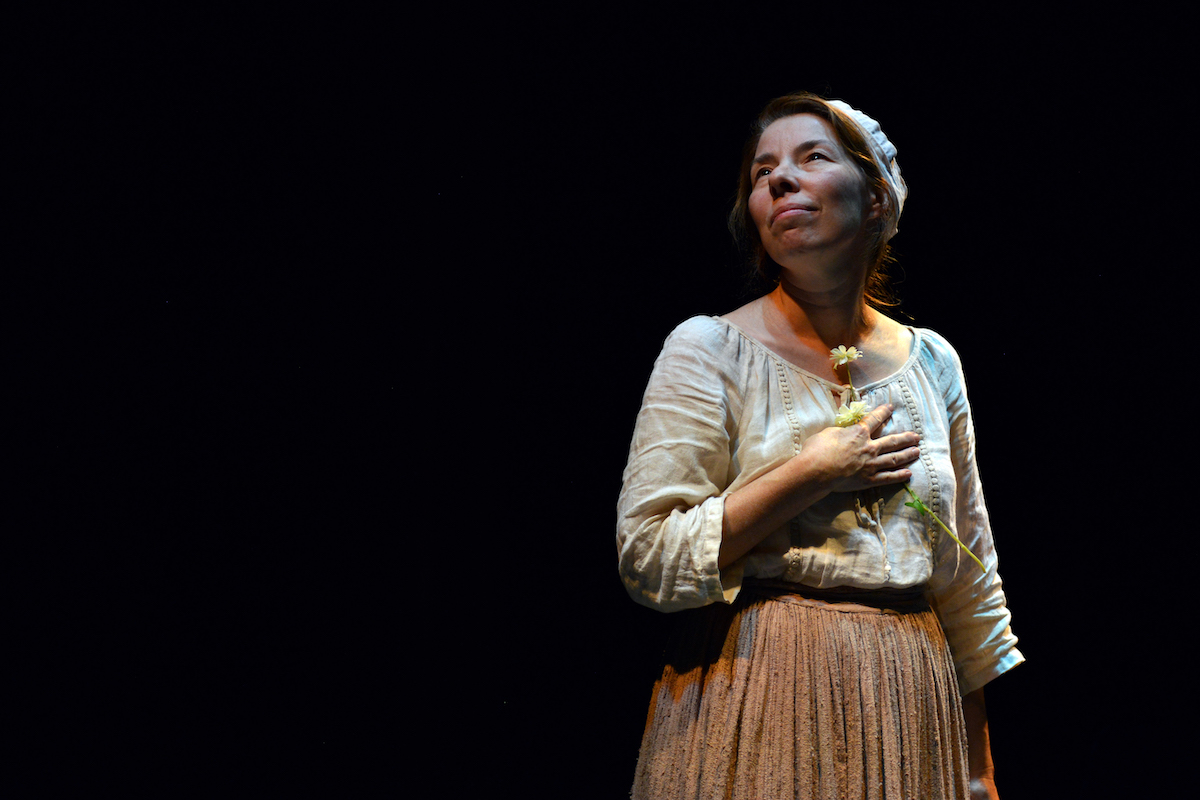The story of Joan of Arc is one that has been told, retold, adapted, musicalized, and allegorically fictionalized. Jane Anderson’s play about the historical and now mythical figure, told through her mother’s perspective, is an interesting approach, in theory. And, as we learn in the sporadic, self- referential monologues Isabelle delivers, she went on to do her most important work, after her daughter’s death. She learned to read and write, went to Rome and petitioned the Pope to reopen Joan’s case, eventually getting the verdict overturned, opening up the chance for Joan to be canonized. But those facts are not what the play dramatizes unfortunately. They are only given to us during her third-person closing speech.
So why should we care about Joan of Arc’s mother? One would hope the play itself would shed light on their relationship, or show the nuances of the family dynamics of a woman who claimed to receive guidance from saints. Perhaps even to show the emotional state of a teenaged woman going to war, and her supportive but apprehensive mother. However, the play relies on declarative exposition, and the form is so contrary to the 15th century world of the play, that even the most sympathetic audience member would have a hard time cracking the surface of connecting to Isabelle. The style of text feels almost like a Martin McDonagh play: using contemporary colloquialisms, quick volleyed pacing, and contractioned slang: “I don’t wanna be no lousy abbess.” Yet the design meticulously portrays life in rural France in the 1420s.
In fact, the costume, set, lighting, and sound design for this play was a gorgeous, painstaking representation of an environment to which the text could not live up. Carolyn Rapanos’ set elegantly transformed from farm house to castle rooms, and back, with the help of Jonathan Kim’s subtle and descriptive lights, and Mary Jane Pacquette’s atmospherically moving sound design. Stephanie Kong’s and Jessica Oostergo’s detailed, layered, period-perfect costumes highlighted the passage of time, and rounded out the characters, where the writing did not.

One of the more interesting characters (not just for her beautiful costumes) was The Lady of the Court, whose scene with Isabelle was probably one of the more fleshed out in the play, simply because there was no exposition: just two characters on stage, communicating. The performances were not lacking either. Anita Wittenberg carried the evening on her shoulders, justifying every strange textual device thrown at her. Most scenes felt expository, like they were just satisfying the historical timeline of Joan’s narrative, and forcing the actors to breathlessly explain event after event. Had Wittenberg been allowed to listen more, declare less, let us see her cogs spinning, and enjoy the learning and strategic mind and sympathetic heart Joan would have inherited, there would have been a little more space for her to emotionally express the stakes at hand.

That being said, the tone of the second to last scene shared between Joan and Isabelle was where the whole play could have lived. In an attempt to save her life, Isabelle asserts that Joan is not seeing St. Catherine, so Joan will renounce her heretical beliefs, and perhaps be acquitted. Isabella’s betrayal of faith in her daughter’s visions could have stood in beautiful emotional contrast with the final scene between her and Joan in which there is no hope. Joan is about to be burned at the stake. Isabelle tells Joan “I spoke to her,” and tells her St. Catherine is going to make sure everything’s okay. However, this is the last dramatized scene in the play: almost too late to have lasting emotional impact on the audience. Also, it’s worth noting that the devastating Raes Calvert as Jacques was underused as Joan’s long-suffering father, who was never in support of Joan joining the army, and sees his family torn apart by the political events of the war.

Pacific Theatre did their best with what is inherently a flawed piece. It had similar problems when it first premiered in 2015 that Shakespeare in Company in Lenox Massachusetts, and three years later, when Glenn Close starred as Isabelle at the Public Theatre. The tone is muddled, the writing doesn’t match the design, or the world of the play the director is trying to build. It is possible to make a contemporary commentary play with period language. See Arthur Miller’s The Crucible. It becomes especially confusing when the writer has no ancestral claims to the colloquialisms she’s employing. Joan and her brother calling their parents “Ma” and “Da” or using “grand” or “bloody.” Anderson is from California, and wrote for shows like “Mad Men,” “Olive Kitteridge,” and films like “The Wife,” all for which she’s been critically praised. But there was no justification for the style of text for this particular piece.
All this makes me beg the question, why do this play the way it was presented at The Public? If it didn’t work then, why would it work now? Why not embrace the script, and modernize the whole thing? If this production leaned into the contemporary language with its direction and design, it could have achieved the potential of a family drama written as a commentary on class divide. It could have underscored a woman rising up despite all odds stacked against her. And I don’t mean Joan.
Mother of the Maid is playing at the Pacific Theatre Sept 13 – October 5. Wed-Sat at 8pm with 2pm matinees Saturdays.
By Jessica Aquila Cymerman
Production photos courtesy of Pacific Theatre. Photo Credit: Jalen Laine Photography
[wdi_feed id=”2″]


One of the character that interest me was ” the lady of the court “. She really a good actress. and her performance stand-out.
It is a really moving story that I would recommend you to see if you ever get the opportunity. I look forward to any plays that are happening in my town as it is the best thing to watch.